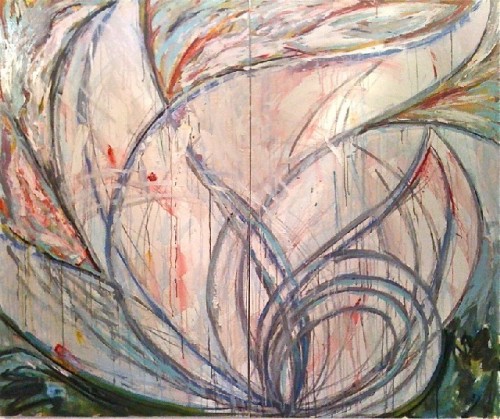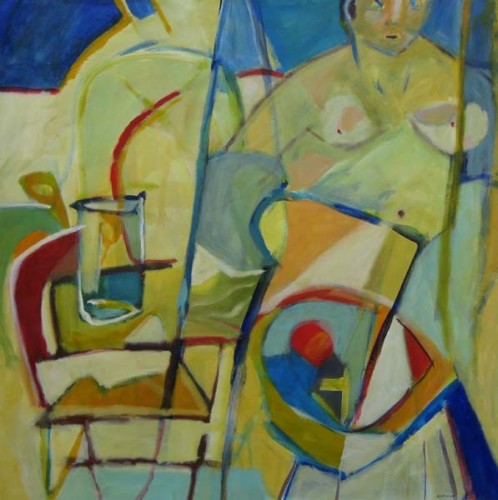Boston Artists Addison Parks and Jim Falck
Reflecting On Optical Origins
By: Martin Mugar - Aug 17, 2012
Art at its best reflects on its own optical origins. Even when it appears to be breaking away into new territory as in the work of the Impressionists and the Post Impressionists it is meditating on its roots that were evident in the optics of the perspective of the Renaissance and the chiaroscuro of the early Baroque. Western art seems to fluctuate back and forth between seminal periods of rigorously based optically grounded art and art that takes that construct as dogma and perceives it as reality. My favorite concept from Marxist criticism is the notion of reification. It is used to critique concepts of social organization that are taken for reality rather than as a human invention. It can be applied to art when the world of bourgeoisie for example is solidified in the realism of the late 19thc . Although used by the Marxists to accuse people of bourgeois bad faith and to recommend them for a curative stay in the gulag, when used to critique art it does a pretty good job of detecting when large groups of people smugly take the shape of things in the visual world as just the way things are.
A good example of reification was evident in the work I saw of many, heretofore unknown to me, realists at the Petit Palais in Paris who appeared to be followers of Courbet’s social realism. Their subjects were the poor of Paris. One huge large scale painting showed a street theatre presentation comprised mostly of young children whose sorrowful looks conveyed obvious exploitation. In my essay on my blog on the Impressionist show at the MFA from the the mid 90’s I quoted Michael Baxandall who felt that the work of Chardin drew its strength from the way it understood that the structuring of the visual reality had its roots in the eye/mind and its language of chiaroscuro. http://martinmugar.blogspot.com/2011/11/modern-arts-considered-this-article-for.html
This notion becomes reified in the hands of the artist of the late 19thc where the balance between seer and seen is lost. The paintings are too much about the sad eyed urchins and not the event of seeing them. The limpidity for example of the work of Caravaggio is achieved by its hypersensitivity to how the eye organizes the visual world. Subtle distinctions between the seer and the seen (scene) are the sine qua non of great art.
In the 20thc this balancing of that distinction is most evident in the work of the Abstract Expressionists. The evanescence of Rothko’s late work appears as an optical apparition. It partakes of the reductionist chromatic trope supported by Greenberg’s philosophy but stays rooted in the language of seeing in its use of subtly juxtaposed warms and cools. It stays in the Western Tradition of seeing that goes back to Vermeer and in fact his work seems at times to be a detail of, say a pearl, on the necklace of the woman in one of his most famous paintings, the so-called “Woman with a Pearl Necklace”.
Rothko’s work has been seen as an example of Talmudic mysticism. When it comes to respecting the namelessness of God it seems Abstraction is a most authentic vehicle .It intrigues me as I hear myself use seer and seen that it resonates with the words of mystics from the Upanishads. Or the constant reference to the struggle to merge the observer and the observed in the work of Krishnamurti evidenced by his constant frustration at finding the right word for this conundrum.
There seems to be a relationship between the interest in how the eye sees and mysticism .If the cognitive structure of the eye shapes reality, then an exploration of this structure puts the artist on the edge of knowing and unknowing. Is it any surprise that the artists who walk this line this razor’s edge are not the happiest people in the world? The comforting sense that the world we move in is a seamless whole has not been granted to them. A simple figure/ground exercise for Rothko becomes a meditation on Being and Nothingness.
For the artist who pursues abstraction the risk of reification becomes enormous. There is the assumption that of course abstraction is not reality so there is no risk but it can be as leaden as a Bougereau. It seems that artists think theyt are given two choices that they think are incompatible: Either you have a unique vision or you are a follower. They the idea that you have to be both seems to escape then. If you are influenced you really can’t be an artist. This seems to be the case of the winners of a recent annual art show and competition comprised of New England Artists in which I was included. In its generosity to include as many artists as possible it ran the gamut between sophistic and amateur. The art is divided into work selected by an outside curator and the rest is included in a concurrent show with another name. In the end there was not much difference in quality between the two groups. For the most part the show is made up of Abstraction that wallows in a mix of expressionist mark making and a vague sense of pattern and Photorealist work both of which seemed to catch the eye of the outside curator. The abstract artists did not question or embrace their roots and they were among the winners of the competition. It would have been refreshing to see some humble exploration of the rich language of 20thc abstraction.
We are in a post-ideological era in art. Therefore, the realism does not have the back up of a movement as it did in the late sixties and the abstraction does not have the austere words of Ad Reinhardt to push it toward purity. Maybe that is a good thing. But the results are not encouraging for the future of painting. In this show the work floats on its own merits, which are no longer to seduce the viewer from its ideological purity but to do so by the lowest common denominator of emotionality in the case of abstraction or crass facticity in the case of the realism. I suppose that this is a normal evolution similar to that from the High Renaissance to the Mannerists in Italy, before chiaroscuro regrounded painting in the Baroque. But in the case of the prizewinners they show no intelligence in regards to their sources. Like little bubble boys and girls they can’t absorb any influences. They suffer from terminal narcissism. Maybe that is the Modern aesthetic. The current manifestation of reification.
I can think of two artists who are presently painting in the Boston area whose art radiates a gracious interest in the tradition of painting Jim Falck and Addison Parks. For them the tradition is the period of the beginning of the 20thc : The world of Matisse and Picasso which could be summed up as the pushing of paint with the dynamics of color and figure ground toward the simplicity of the written word. Recently I witnessed the finished product of a mural Jim was asked to do at the gallery at Montserrat College of Art. It was a full sized mural that was constructed of abstracted figures woven together with as much understanding of time and space as Picasso’s “Desmoiselles d’Avignon”. Figure and ground give the figures a visual life that keeps the viewer’s eye constantly moving. The colors bounce back and forth between warm and cool to create a mood of sunlit Italy and the Mediterranean. This is not a blind use of the tradition but a respect for how it can integrate the figure into the environment to create one organic being, which is “Life”. Jim’s favorite word. All one had to do was compare his mural to the other ones done on adjacent walls to know how smart Jim is. They were just additive .One mark on top of the other with no sense of integration.
Addison nourishes his work with the artists he loves, Hoffmann and Marin, Hartley and Miro. Here is the love of painting as language that allows for buoyancy and joy to permeate the work. The language paints the painting. This guy lives art, thinks art. There is such an abundance of letting things be, through the language of painting. Parks who is a writer knows how words live as part of an organic whole. You never know how they will react when they are juxtaposed with each other. No ponderous attempt to say something deep just to show how profound one is.
In a culture where everything has its shelf life I don’t expect the art community to carry these artists on their shoulders through the streets of Boston as local heroes. I have been in Boston long enough to recall the hushed tones with which a new local art hero is discussed and remember that in every case the work of these artists has reeked of emotionality. The art dealers knew that was needed for it to jump off the shelf in the art supermarket. None of these artists were capable of organic growth. Their success made that inevitable. For Falck and Parks , their love of art as a language has a life of its own and because it is life itself it breathes and pulsates and continue to grow.
Reposted with permission of Martin Mugar from his website Painting.



